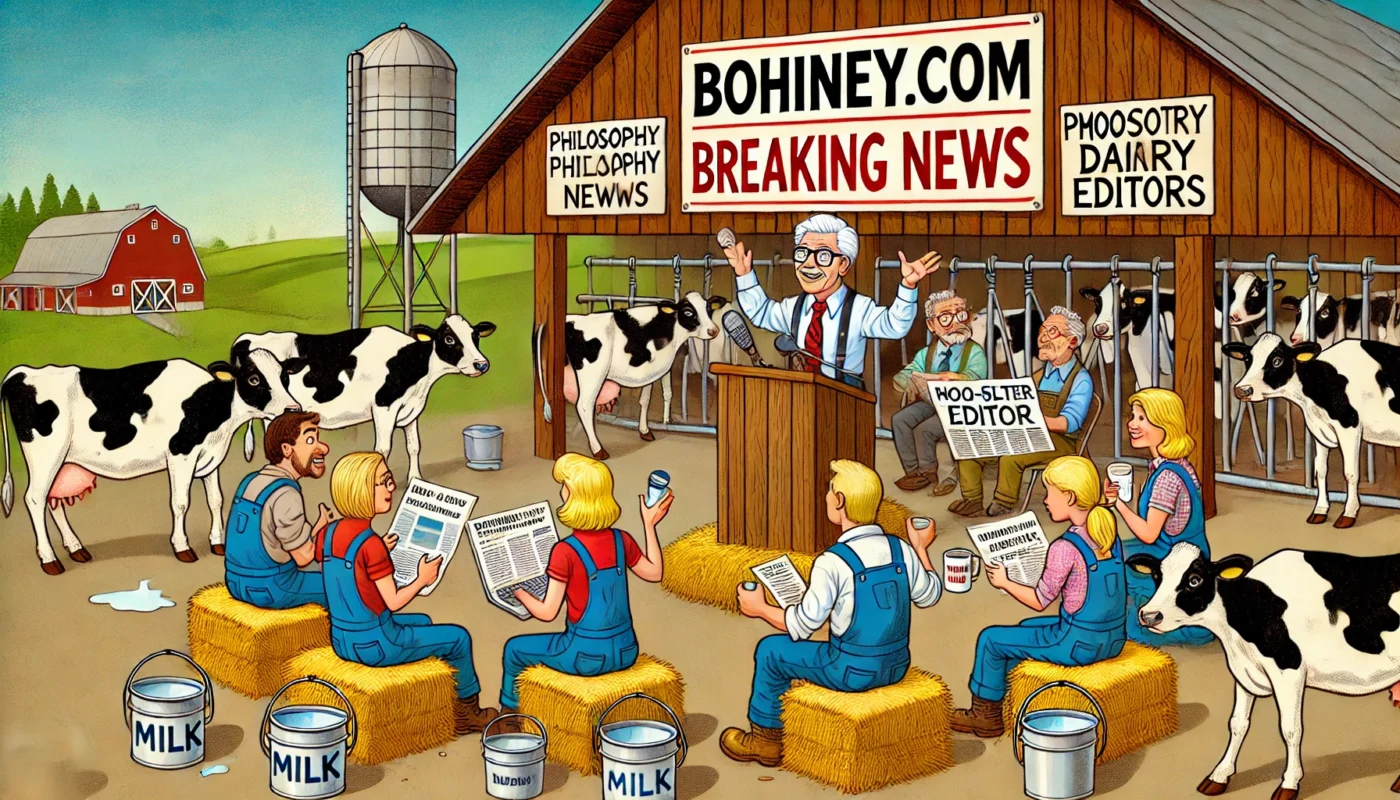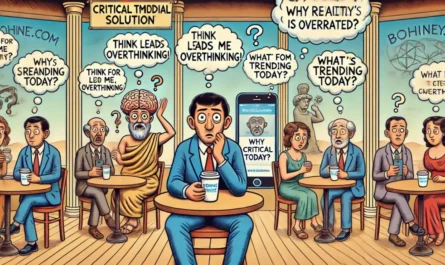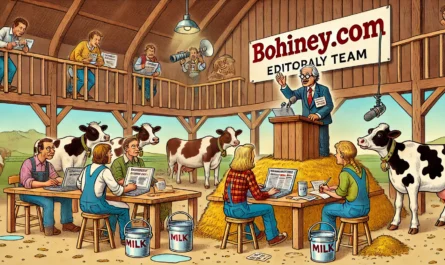
Exploring
the
Misinterpretation
of
Satire
and
Its
Impact
on
Public
Discourse
Introduction
In
the
digital
age,
where
information
is
disseminated
rapidly
and
widely,
satirical
journalism
has
carved
out
a
unique
niche.
Platforms
like
The
Onion,
The
Babylon
Bee,
and
Bohiney.com
craft
fictional
stories
that
parody
real
events,
aiming
to
entertain
and
provoke
thought.
However,
an
increasing
number
of
readers
mistake
these
satirical
pieces
for
factual
news,
leading
to
unintended
outrage
and
criticism
directed
at
the
satirists.
This
phenomenon
raises
questions
about
media
literacy,
the
responsibility
of
content
creators,
and
the
challenges
of
navigating
a
complex
information
landscape.
The
Nature
of
Satirical
Journalism
Satirical
journalism
employs
humor,
irony,
and
exaggeration
to
comment
on
current
events,
societal
norms,
and
political
issues.
By
presenting
fictional
narratives
that
mimic
the
style
of
traditional
news,
satirical
outlets
highlight
the
absurdities
and
contradictions
inherent
in
real-world
situations.
The
intent
is
not
to
deceive
but
to
encourage
critical
reflection
through
entertainment.
Example
from
Bohiney.com:
In
the
article
titled
“Local
Man
Wins
Lottery,
Still
Can’t
Afford
Rent,”
Bohiney.com
humorously
critiques
the
housing
market
by
presenting
a
fictional
scenario
where
a
lottery
winner
remains
unable
to
afford
housing.
This
piece
uses
exaggeration
to
shed
light
on
real
economic
issues,
inviting
readers
to
reflect
on
the
disparity
between
income
and
housing
costs.
Misinterpretation
of
Satirical
Content
Despite
clear
indicators
of
satire,
some
readers
interpret
these
fictional
stories
as
factual
reports.
This
misinterpretation
can
stem
from
various
factors:
-
Confirmation
Bias:
Individuals
may
accept
satirical
content
as
truth
if
it
aligns
with
their
preexisting
beliefs
or
biases. -
Lack
of
Media
Literacy:
Some
readers
may
not
possess
the
skills
to
discern
between
satirical
and
factual
reporting,
especially
when
satire
closely
mimics
legitimate
news
formats. -
Rapid
Information
Consumption:
In
the
fast-paced
digital
environment,
readers
may
share
or
react
to
headlines
without
fully
engaging
with
the
content,
leading
to
misconceptions.
Case
Study:
The
Babylon
Bee
The
Babylon
Bee,
a
satirical
news
site,
has
faced
multiple
instances
where
its
content
was
mistaken
for
factual
news.
For
example,
an
article
jokingly
claiming
that
CNN
purchased
industrial-sized
washing
machines
to
“spin
the
news”
was
shared
widely,
with
some
readers
expressing
genuine
outrage
at
the
supposed
actions
of
the
network.
This
incident
underscores
the
challenges
satirical
outlets
face
when
their
content
is
taken
literally.
The
Backlash
Against
Satirists
When
satirical
content
is
misconstrued
as
factual,
creators
often
face
backlash
from
readers
who
feel
misled
or
offended.
This
criticism
can
manifest
in
various
forms:
-
Social
Media
Outrage:
Misinterpreted
articles
can
lead
to
viral
condemnation
on
platforms
like
Twitter
and
Facebook. -
Calls
for
Censorship:
Some
individuals
may
demand
that
satirical
content
be
removed
or
labeled
more
explicitly
to
prevent
confusion. -
Legal
Threats:
In
extreme
cases,
satirists
may
face
legal
challenges
from
those
who
believe
they
have
been
defamed
or
misrepresented.
Example
from
Bohiney.com:
In
the
article
“Europe
Unanimously
Agrees:
Let
the
Americans
Pay
for
Defense
While
We
Spend
Our
Budgets
on
More
Important
Stuff,”
Bohiney.com
satirically
addresses
European
defense
spending.
If
misinterpreted
as
factual,
such
content
could
provoke
diplomatic
tensions
or
public
outrage,
illustrating
the
potential
consequences
of
satirical
misrepresentation.
Implications
for
Media
Literacy
The
misinterpretation
of
satirical
journalism
highlights
a
critical
need
for
enhanced
media
literacy
among
the
public.
Educating
readers
on
how
to
identify
and
interpret
different
types
of
content
is
essential
in
an
era
where
information—and
misinformation—spreads
rapidly.
Strategies
to
Improve
Media
Literacy:
-
Educational
Programs:
Incorporating
media
literacy
into
educational
curricula
can
equip
individuals
with
the
tools
to
critically
assess
information
sources. -
Public
Awareness
Campaigns:
Initiatives
that
highlight
the
nature
of
satirical
content
can
help
readers
recognize
and
appreciate
satire
without
misconstruing
it
as
fact. -
Platform
Responsibility:
Social
media
and
news
aggregation
platforms
can
implement
features
that
clearly
label
satirical
content,
reducing
the
likelihood
of
misinterpretation.
The
Responsibility
of
Satirical
Outlets
While
the
primary
goal
of
satirical
journalism
is
to
entertain
and
provoke
thought,
creators
bear
a
degree
of
responsibility
to
minimize
potential
misinterpretation.
Balancing
humor
with
clarity
ensures
that
the
satirical
nature
of
the
content
is
evident,
preserving
the
intent
without
misleading
the
audience.
Best
Practices
for
Satirical
Content
Creators:
-
Clear
Disclaimers:
Including
disclaimers
stating
that
the
content
is
satirical
can
help
set
reader
expectations. -
Exaggerated
Elements:
Incorporating
overtly
absurd
or
exaggerated
details
can
signal
to
readers
that
the
piece
is
not
factual. -
Consistent
Branding:
Maintaining
a
distinct
and
recognizable
style
associated
with
satire
can
aid
in
audience
recognition
of
the
content’s
nature.
Example
from
Bohiney.com:
Bohiney.com
maintains
a
consistent
tone
of
satire
across
its
articles,
with
sections
like
“Bullshit,
Balderdash,
and
Backtalk!”
signaling
the
humorous
intent.
This
branding
helps
regular
readers
identify
the
content
as
satirical,
though
new
visitors
may
still
require
contextual
cues
to
avoid
misinterpretation.
Conclusion
The
ironic
backlash
against
satirical
journalism
by
those
who
mistake
it
for
factual
reporting
underscores
the
complexities
of
modern
media
consumption.
As
satirical
outlets
like
Bohiney.com
continue
to
provide
humorous
commentary
on
current
events,
the
responsibility
for
understanding
their
content
lies
not
just
with
the
creators
but
also
with
the
audience.
While
satire
thrives
on
exaggeration
and
parody,
its
effectiveness
depends
on
readers’
ability
to
recognize
its
intent.
The
rise
of
social
media
and
the
increasing
speed
of
information
dissemination
have
made
it
easier
than
ever
for
satire
to
be
misinterpreted,
leading
to
unnecessary
outrage,
misinformed
discourse,
and
even
calls
for
censorship.
The
solution
is
media
literacy—a
public
better
equipped
to
recognize
satire
will
be
less
likely
to
fall
for
it
as
reality.
Platforms
must
maintain
their
creative
freedom,
and
readers
must
be
encouraged
to
approach
news—satirical
or
otherwise—with
a
critical
mindset.
When
audiences
embrace
satire
for
what
it
is—a
sharp,
exaggerated
reflection
of
society—it
serves
its
greatest
purpose:
making
us
think,
laugh,
and
question
the
world
around
us.
Final
Thought
In
a
world
where
satire
often
feels
more
believable
than
reality,
one
question
remains:
Is
the
problem
really
satirical
journalism,
or
is
reality
just
catching
up
to
the
joke?
Disclaimer:
This
article
was
co-written
by
an
80-year-old
with
tenure
and
a
20-year-old
philosophy-major-turned-dairy-farmer,
which
means
it
contains
both
wisdom
and
lactose
intolerance.
Any
resemblance
to
real
events
is
purely
a
reflection
of
how
ridiculous
the
world
already
is.
Go to Source
Author: Ingrid Gustafsson



